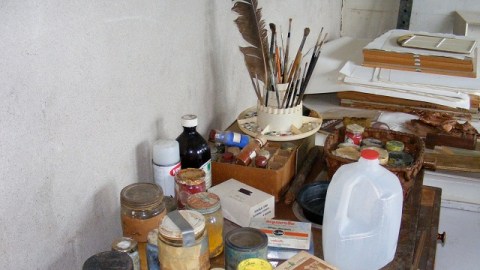What Secrets Lurk in Andrew Wyeth’s Studio?

When painter Andrew Wyeth passed away in 2009, the reclusive painter took many of the secrets behind his art to the grave. When I heard that the Brandywine River Museum had opened up The Andrew Wyeth Studio, where both the art and the legends happened, I wondered just how many secrets would be revealed and how many would lurk in the shadows, still hiding somewhere and somehow. Wyeth worked hard for his cherished privacy during his lifetime, so entering his domain even after his death feels like an intrusion. But if an artist’s studio is a window into his soul, then a walk through Andrew Wyeth’s tour is a journey into the darkest and brightest depths of his art.
The building that would become Wyeth’s studio began as a schoolhouse in 1875 and served in that capacity until the 1920s. Wyeth’s father, the artist N.C. Wyeth, purchased the building for his newly married son and daughter-in-law to live and work in. Restorers returned the kitchen area to its circa 1950s glory with vintage furniture and appliances to give you a sense of what it was like for the young couple and their two boys—Nicholas and Jamie, who carried on the family tradition in becoming an artist himself. A slide show of black and white photos from family Christmas pasts set in the larger family room makes you feel like you’re sharing the holidays with them. The Wyeths moved to a bigger home in the early 1960s, but Wyeth continued to use the building as his studio until his death—nearly seven decades of creativity in one spot.
You enter the building through a door still marked with signs dissuading visitors from asking for autographs and warning about a dog. That warning soon gives way to a welcoming hall filled with pictures of Wyeth’s family, friends, and models (three categories that usually overlapped). A montage of photos of cowboy-hat-wearing Peter Hurd, Wyeth’s brother-in-law and the man credited with teaching him tempera painting, graces one wall. Photos of famous Wyeth models such as Walt Anderson, Ralph Kline, and even Andy’s dog Rattler cover another wall. On the two narrower walls at either end of the hall a series of photographs of Andy laughing with the young Siri Erickson (who would embody young female beauty in a series of portraits) faces a framed print of a detail from Botticelli’s Primavera showing the garlanded young woman (a motif Wyeth would copy for his portrait of long-time model and assistant Helga Testorf
Titled Crown of Flowers).
A short walk down another photo-covered hallway leads to the library, where the skeleton from Dr. Syn greets you with the macabre, Halloween humor Andy enjoyed immensely. Unfortunately, you’re not allowed to touch the books that line the shelves, but I wished intensely to pull down a volume and see what pages were flecked with paint as clues to which images inspired Andy enough for him to keep open while working. The obvious heroes appear (Durer, Bruegel, Winslow Homer, Thomas Eakins, and Rockwell Kent), but more unusual, intriguing names such as Salvador Dali, Pisanello, and Giovanni Segantini (whom N.C. Wyeth idolized) appeared on the silent book spines, making me hope that scholars will someday be allowed to crack those books open, as well as those in the other libraries scattered among Andy’s homes and offices. Near the floor, beneath the books, you find old film canisters marked in Wyeth’s own distinctive way of printing tell you they once contained the exploits of Douglas Fairbanks, Jr., Errol Flynn, and other gallants in Captain Blood, Wings, and Santa Fe Trail.
Wyeth the film buff never tired of showing King Vidor’s The Big Parade to friends and family. A vintage projector set up in the family room in front of a movie screen provides the illusion that Andy will pop out from behind the furniture and dim the lights for another screening. Fencing foils and masks Wyeth used for his favorite sport line the windowsills. Military costumes and weapons from his collection hang from a Dutch colonial wardrobe and other furniture, many of which appeared in Wyeth’s paintings (which the museum has helpfully reproduced in prints to jog the memory). Glass cases contain just a fraction of Andy’s immense collection of toy soldiers recasting conflicts throughout history. Next to those cases stands the door to the studio itself, the sanctum sanctorum only those invited by Andy himself could enter—until now.
The painting area itself is roped off, but you can clearly see the artful disarray of the Wyeth mind at work. On your left sit the jars of dry pigment and a (prop) box of eggs Wyeth would mix to create his tempera paints (shown above). A bird’s feather mingles with the brushes as a characteristic touch of Wyeth’s love of art and nature intertwined. Photos of Andy’s triumvirate of artistic heroes—his father, Howard Pyle, and Peter Hurd—hang on the wall between the light-bearing windows. Photos of Andy’s wife Betsy remain tacked to the back wall of the studio, near a mirror Wyeth would use to view paintings from a different perspective. Look down on the floor, however, and you see little of the famous splatter that the “wild painter” Wyeth famously left in his wake. Look up at the ceiling and you wonder if the ceiling will fall on you. (Fortunately, the conservators structurally restored the partially falling building before allowing tours to enter.) It’s a mix of Wyeth at his wildest and most dangerous but, alas, at times his most sanitized.
The museum reserved a corner of the big family room for Jamie’s work, where the artist himself restaged how he worked on his portrait of the late President Kennedy, sometimes with cotton in his ears to drown out the classical music his father would blast through the rooms as he worked. This sense of a family affair gives warmth to the art itself, which is already full of warmth and humanity. And, yet, even this staging, this revelation that Andy wasn’t the lone wolf of legend, makes you wish for more information about the ghostly, despite still living presence of Helga Testorf—the (in)famous subject of The Helga Painings and Wyeth’s assistant until the end. As a 1988 painting in the Brandywine River Museum’s accompanying exhibition A Painter’s View: The Andrew Wyeth Studio(a collection of works about the studio or the surrounding grounds on view through October 28, 2012) titled simply Helga Painting documents, Helga herself painted beside Andy. Where are those paintings? Will we ever see them? What secrets, if any, do they hold from the last quarter century of this major American artist’s life?
For every revelation made by The Andrew Wyeth Studio (which will conduct tours Tuesday through Sunday through November 18, 2012, and then reopen in the spring), several more questions emerge as you walk through the rooms. A masterfully rendered drawing of a leaf on the wall beside the fireplace in the great room inevitably leads to questions of who did it and why. What’s the story behind such a tiny detail? We may never know, which is the frustrating and fascinating reality of both Wyeth’s art and, now, his open studio. Even if you also tour the N.C. Wyeth House and Studio and the Kuerner Farm, two other sites so prominent in Andrew Wyeth’s art and personal history, you’ll only scratch the surface of this artist who more than any other American artist linked his work to a specific place and the people who lived there. For anyone who visits The Andrew Wyeth Studio looking for answers, be prepared to walk away with more questions.
[Image: Table covered with paints and brushes inside The Andrew Wyeth Studio. Photo courtesy of David Livewell. Copyright David Livewell.]
[Many thanks to the Brandywine River Museum for providing me and a colleague with press passes to view The Andrew Wyeth Studio, tours of which are held Tuesday through Sunday through November 18, 2012. The accompanying exhibition A Painter’s View: The Andrew Wyeth Studiois on view through October 28, 2012. Many thanks, too, to David Livewell for his photography and invaluable insights on the Wyeths.]
[Please note that I will be posting on the Christian Sanderson Museum, home to many works by the Wyeths as well as an idiosyncratic, yet unforgettable collection of Americana.]




